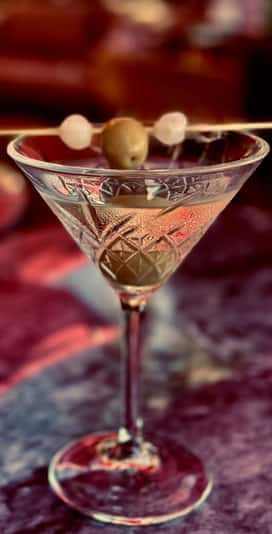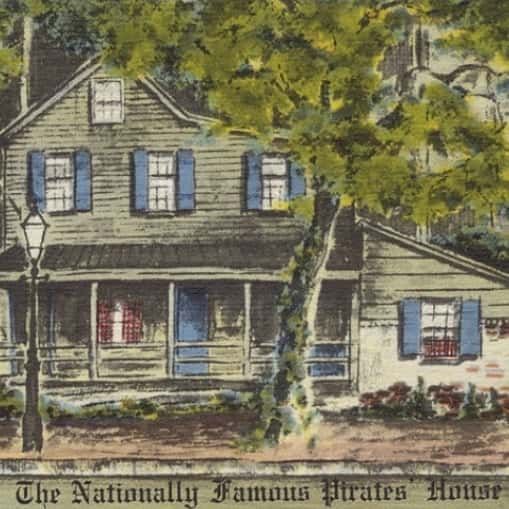Find Revelry in America's Favorite Cities Our Destinations
So you finally made it. You’re in The Hostess City of the South, and you are ready to party hard. Where to even begin?! Let me give you some fun facts about some unique cocktails born and bred in Savannah that are simply a must-have when you visit the city.
This cocktail is probably the one that Savannah is most known for. They say it’s been served since colonial times and was rumored to be first served from large horse barrels with a ladle for soldiers during the Revolutionary War. It’s named after the Chatham Artillery Unit, and may have been created by them too.
If you’re looking for a drink that will pick you up and sit you back down, this punch is just what you need. The recipe tends to vary depending on who makes it, but it’s usually some mix of tea, brandy, champagne, rum, and bourbon.
One sip of this emulsion, and you will surely never be the same.
This one is a bonafide crowd-pleaser that needs more ingredients than your usual.Ingredients:
2 quarts green tea
Juice of 1 dozen lemons
1 1/4 pounds Light Brown Sugar
2 quarts dessert wine of choice
2 quarts dark rum
1 quart Hennessy
1 quart dry gin
1 quart rye whiskey
2 cups cherries
2 cups pineapple cubes
2 1/2 quarts champagne
(You have permission to mess with the proportions as much as you want)
Mix tea with lemon juice, then add brown sugar and various alcohols. Let the mixture sit for at least 1 week or preferably 2 weeks, in a covered container.

After the setting period, pour the mixture into a large punch bowl filled with ice.
Add cherries, pineapple cubes, and champagne. Mix and enjoy!
The Martini was not born in Savannah, but it certainly has a strong foothold here. You may have heard of a certain poet and short story writer by the name of Conrad Aiken.
According to Savannah legend, Aiken desired to have his headstone at his grave in Bonaventure Cemetery fashioned into a bench.
The reason? He wanted guests of the city to sit and have a martini with him in spirit. Now, Bonaventure strictly prohibits alcohol, so maybe don’t try that today.
But Savannah knows how to make a mean Martini any place you go, so find a cozy pub and raise one up in Aiken’s honor.
Ingredients:
2 1/2 ounces gin
1/2 ounce dry vermouth
1/2 ounce olive brine
Optional garnish: 2 to 4 olives
Add vermouth, gin, and olive brine to a mixer filled to the brim with ice. Shake vigorously. Strain into a chilled martini glass and garnish with olives.
If you’re new to Savannah, Lulu’s Chocolate Bar needs to be a must-visit for you. Lulu’s is a dessert bar that serves a mouth-watering array of cakes, pies, candies, and dessert wines that will hit your sweet spot just right.
The Lulutini is a local favorite that is an irresistible mix of chocolate vodka and liquor that simply can’t be missed.
Sorry Charlie’s is one of the most popular restaurants in downtown Savannah. The building is over 200 years old and is the oldest continuously operating building in Savannah.
Fun fact: the fish sign that hangs off the side of the building has been designated as a historical artifact by the Historic Savannah Foundation!
The mouthwatering punch is a boozy mix of brandy, cognac, rum, and lemon juice. According to the restaurant, this recipe has been poured in the Georgia colony since 1732, and it is still a hit to this day!
The Crystal Beer Parlour is one of the longest-running and popular restaurants for Savannah natives and visitors alike. Before the building was a restaurant, it was a grocery store that was open throughout the early 1900s.
The walls are lined with some of Savannah's most infamous residents and cherished memories too long to list.
One of the house favorites is the CBP Pain Killer which is made of rum, cinnamon liquor, coconut creme, pineapple, and orange juice.
Crystal is also famous for having rare and limited edition beers, IPAs, and ciders. Simply a must-have when you come into town!
The Pirate’s House restaurant is the oldest building in the city. In the mid-1700s, the building was intended to be an Inn for seafarers and had visits from more than a few naughty pirates.
The history of the building is long and colorful, but not as colorful as the drinks! Pirate’s house serves an array of beautiful, delicious, and boozy mixtures that will give you a bang for your buck.

The Dark and Stormy is a fan favorite with its mix of rum and ginger beer, which is said to have been a favorite of Pirates back in the day. With that in mind, any trip to Pirate’s House is meant to be a good time. Come for the drinks, stay for the ghosts!
This one isn’t exactly a cocktail, but it’s an honorable mention. Madeira Wine is a dry wine crafted and bottled off the coast of Africa on the Madeira Islands.
The wine soared in popularity in the 17th and 18th centuries and was famously used to toast the Declaration of Independence. The drink was also a favorite of Alexander Hamilton, George Washington, and John Adams, all key characters during and following the American Revolution.
Many people don’t know that many crucial battles, visits from key figures, and emotional uprisings occurred in Savannah.
With a wine so popularly enjoyed by figures so detrimental to our country’s independence, why not raise a glass in memory of those who fought and died on Savannah soil to give our country freedom?
I’ve given you quite a few options to choose from but make no mistake; there is so much more! The only way to find out exactly how much more is to bring your ass to Savannah and experience it for yourself. Pick your poison but don’t get too comfortable with just one drink because cocktails in this city are serious business.
In 1798, an enterprising fellow named Henri-Louis Pernod got his hands on the absinthe recipe. If Pernod rings a bell, that’s because his distillery is still churning out the good stuff today. But absinthe didn’t immediately take France by storm. It needed a few historical twists and turns to become the drink of choice for poets, painters, and partygoers.
Picture this: It’s 1830, and France and Algeria aren’t exactly on good terms. Algeria was harboring pirates (yes, actual pirates), and France wasn’t thrilled about it. France also owed Algeria money—so naturally, they decided to invade instead of paying up. Classic.
But war isn’t all gunpowder and glory; you need healthy soldiers. That’s where absinthe came in. The high-proof elixir was handed out to French troops to prevent malaria and—thanks to its alcohol content (sometimes hitting 74%!)—as a makeshift disinfectant. Surgery back then was more of a "here’s a drink, bite this stick" kind of situation, so absinthe came in handy.
Soldiers got hooked, and when they returned home, they wanted more. Soon, absinthe was flowing in Parisian bars, gaining traction as France’s new favorite nightcap.
Now, France has always been wine country. But in the 1860s, a microscopic invader changed everything. Enter grape phylloxera, a tiny aphid that hopped across the Atlantic from America and proceeded to destroy nearly half of France’s vineyards. The result? The Great French Wine Blight—a crisis that left wine drinkers scrambling for alternatives.
With wine scarce and expensive, absinthe took center stage. It was local, it was cheap, and it had just the right amount of kick. By the late 1800s, the Green Fairy was soaring. Between 5 and 6 PM, bars were packed with people indulging in l’heure verte—"the green hour." Even after the wine industry bounced back, absinthe had cemented itself as a staple of French drinking culture.
Oscar Wilde sipped it. Vincent van Gogh painted under its influence. Edgar Allan Poe probably saw a ghost or two after a few glasses. The Green Fairy was everywhere.
Success, of course, breeds haters. And the temperance movement hated absinthe.
It all started with a dubious 1864 experiment by French psychiatrist Valentin Magnan. He exposed one guinea pig to alcohol vapor (no problem) and another to wormwood vapor (seizures and convulsions). His conclusion? Wormwood was dangerous and made people go insane.
Thus, the legend of "absinthe madness" was born. People blamed the drink for hallucinations, criminal behavior, and even murder. The real culprit? Most likely the fact that absinthe was often stronger than other alcohol, meaning people got very drunk, very fast.
To be fair, wormwood does contain a chemical called thujone, which, in extremely high doses, can cause convulsions. But here’s the kicker: you’d have to drink yourself to death with absinthe long before thujone had any effect. Modern absinthe contains so little thujone that it’s officially labeled "thujone-free."
Still, thanks to moral panic and one very unfortunate guinea pig, absinthe was banned across Europe and the U.S. between 1905 and 1915. The Green Fairy was exiled.
Luckily, good spirits never stay buried forever. By the 21st century, scientists and drinkers alike realized the fears were overblown. Countries began lifting the bans, and absinthe was legally revived.
Today, she’s back, ready to be sipped in dimly lit bars and whispered about in hushed, boozy tones. Just remember: if you invite the Green Fairy over for a drink, treat her right—she’s stronger than she looks.
Ingredients:
1 ounce of Absinthe
1 ounce of water
Freshly squeezed lemon juice
1 dash of Angostura bitters
2 tablespoons of egg whites
Preparation: Add all ingredients into shaker with ice and shake vigorously. Serve in a coupe glass and garnish with a lemon twist.
Here’s a question for you: if you follow the recipe for making absinthe but label it something else, is it still absinthe?
The answer, of course, is yes. It’s still very much absinthe.
Is it, though? Most countries don’t have a legal definition of what absinthe is, making a ban on absinthe almost impossible to enforce.
In 1934, for instance, the Sazerac company bottled and sold Herbsaint. It’s an almost perfect anagram of absinthe, just with an additional r
.
The added r
likely stands for
regulate this, I dare you.
Sazerac wasn’t the only company that did it, but Herbsaint is one of the best-known absinthe substitutes. They still make it today, even though absinthe is legal again.
Oh yeah, that happened!
In 2007, the U.S. government lifted the ban on absinthe. We’d done enough research to know the Green Fairy just wasn’t the monster she was made out to be.
France followed in 2011. A slew of countries that had previously banned absinthe joined in around the same time.
Our dear friend, the Green Fairy, is free once more to inspire the masses. I encourage you to try some yourself, but do it the right way - dripping water through a sugar cube into it.